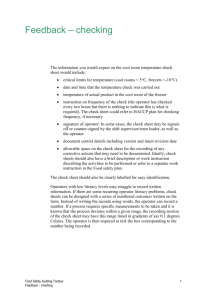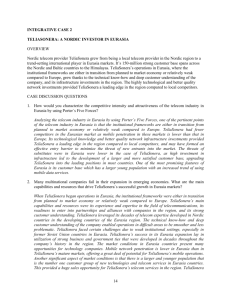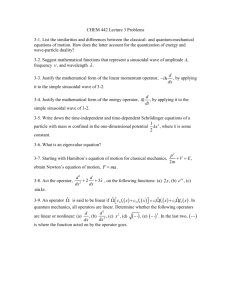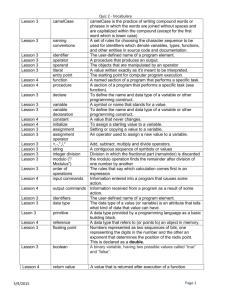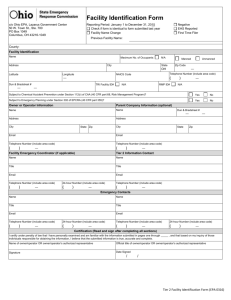Market leader strategies: case Sonera
advertisement
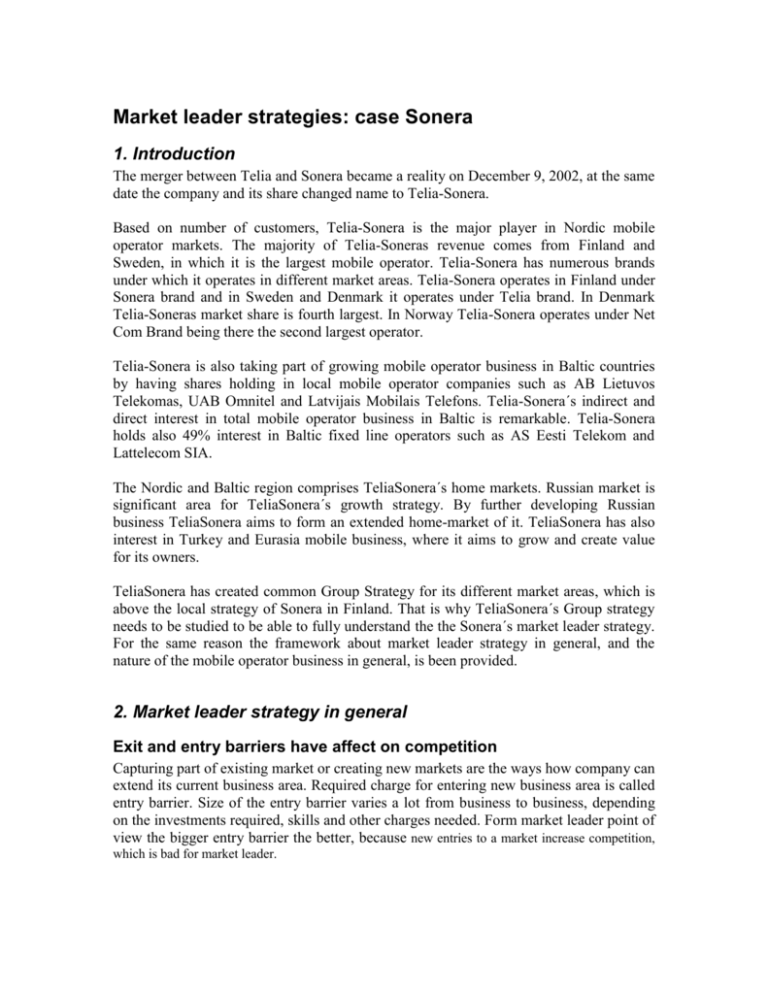
Market leader strategies: case Sonera 1. Introduction The merger between Telia and Sonera became a reality on December 9, 2002, at the same date the company and its share changed name to Telia-Sonera. Based on number of customers, Telia-Sonera is the major player in Nordic mobile operator markets. The majority of Telia-Soneras revenue comes from Finland and Sweden, in which it is the largest mobile operator. Telia-Sonera has numerous brands under which it operates in different market areas. Telia-Sonera operates in Finland under Sonera brand and in Sweden and Denmark it operates under Telia brand. In Denmark Telia-Soneras market share is fourth largest. In Norway Telia-Sonera operates under Net Com Brand being there the second largest operator. Telia-Sonera is also taking part of growing mobile operator business in Baltic countries by having shares holding in local mobile operator companies such as AB Lietuvos Telekomas, UAB Omnitel and Latvijais Mobilais Telefons. Telia-Sonera´s indirect and direct interest in total mobile operator business in Baltic is remarkable. Telia-Sonera holds also 49% interest in Baltic fixed line operators such as AS Eesti Telekom and Lattelecom SIA. The Nordic and Baltic region comprises TeliaSonera´s home markets. Russian market is significant area for TeliaSonera´s growth strategy. By further developing Russian business TeliaSonera aims to form an extended home-market of it. TeliaSonera has also interest in Turkey and Eurasia mobile business, where it aims to grow and create value for its owners. TeliaSonera has created common Group Strategy for its different market areas, which is above the local strategy of Sonera in Finland. That is why TeliaSonera´s Group strategy needs to be studied to be able to fully understand the the Sonera´s market leader strategy. For the same reason the framework about market leader strategy in general, and the nature of the mobile operator business in general, is been provided. 2. Market leader strategy in general Exit and entry barriers have affect on competition Capturing part of existing market or creating new markets are the ways how company can extend its current business area. Required charge for entering new business area is called entry barrier. Size of the entry barrier varies a lot from business to business, depending on the investments required, skills and other charges needed. Form market leader point of view the bigger entry barrier the better, because new entries to a market increase competition, which is bad for market leader. Another barrier is exit barrier, which is the total cost on abandoning the product. The bigger the exit barrier is the more the firm must compete. High exit barriers cause a firm to remain in an industry, even when the venture is not profitable. When the plant and equipment required for manufacturing a product is highly specialized, these assets cannot easily be sold to other buyers in another industry, and the exit barrier is therefore high. The lover the exit barrier is the easier new challengers hand over the market leader. Size of the barriers has effect on profit level and stability of return. If there were no exit and entry barriers at all, the return would always be nominal. That is because companies could start up and leave the business without costs. Big revenues would tempt new companies to the business until the market equilibrium exists and profit would go down to nominal. If exiting business would not cost anything the revenues would be stable. That is because the supply would decrease automatically when the demand decreases, hence the revenues would stay profitable in every situation. In such business has the market leader usually the best capability to stay in business having better balance sheet. Low entry barrier High entry barrier Low exit barrier High exit barrier Low, stable returns Low, risky returns High stable returns High, risky returns Picture 1. Barriers and revenues Framework for market leader strategy The market leader strategy in general consists of three main tasks, which are expanding the total market, protecting the market share, expanding the market share. Each of these tasks is described below. The market leader has usually the greatest margin because it has not need to tempt new customers with lowest possible prices. Bigger margin offers market leader possibility to create new products and services which requires a lot of charging in R&D and advertising. By creating successfully new products market leader can be able to expand the total market while improving its own market share by getting the benefits of the first mover. R&D is risky business because of uncertainty of technology and market reaction is always present and it needs to be considered while implementing the market leader strategy. The risk analysis should be done because expansion failure can be fatal. Many companies reaching the limits of growth in their core business look to new products, mergers, or acquisitions for future expansion. But diversification is inherently risky and the odds of success are poor. Failed growth strategies waste company resources -human and financial. Protecting the market share is the more difficult the lover barrier is to entry into business and the more attractive the current customer segment is from competitor point of view. Customer satisfaction is a key parameter that makes protecting market share possible, it indicates possible weakness in operations and addresses areas where to charge. Measuring customer satisfaction is therefore important task of marketing department of the company. Other important task is to benchmark competitors, and try to find out how they tempt customers, what will be their following moves and implement lucrative moves first. Expanding the market share is possible for market leader also. Keyword to expanding market share is innovation. Product, market segment, distribution and promotion are the areas on which innovations may lead to bigger share of market. The bigger market share is however not the only target which should be pursued. The most profitable level of market share should be pursued, and it is not always the highest level. Somewhere goes the borderline of optimal market share after which the profitability starts to fall down. This is because keeping all the current customers with the lover margin will cost sometimes more than giving up part of the customers and keeping the rest with better profit margin. Profitability Optimal market share 0 % 25 50 % Market % 75 100 % % share Picture 2. Example of profitability curve 3. Nature of mobile operator business There are also few significant features which are typical for mobile operator business in general, and which need to be considered while discussing about market strategies. I have used Forrester´s press releases as a source material for given insights to European wide mobile operator business´ current and becoming trends. Forrester Research provides researches and analysis that identifies and analyzes trends in technology and their impact on business. A decade ago, only 2 percent of the Western European population owned a mobile phone. Today, the number exceeds 80 percent. Similar growth of mobile phone penetration will happen also in developing market areas. The demand is also different in developing mobile operator markets. Since most people are subscribing their first access to mobile phone network the focus is on the regular voice calls instead of advanced services and solutions. The battle for market share of mobile phone users continues in fast growing lower penetration markets such as Baltic countries, Russia and the Far-East. Mobile operators will implement different strategy in those markets focusing on capturing as big share of markets as possible, than in mature western markets. Barrier to enter into business is medium at most since roaming is made possible. That is why lot of new start ups is seen in mobile operator business. Relatively high advertising efforts are yet needed to secure sufficient market share in consumer business. That is why most new entries in mobile operator business tend to have only marginal market share for long time. Exit barrier is in turn quite low because of little infrastructure needed because the license can be resold, thus the exits will be seen more often while competition gets harder. Marketing is playing the key role in all consumer product business. In mobile operator business it might be even more essential than it is in consumer business in general. That is because the product is used to be almost the same except the price. Pointing out the superiority of properties is challenging, since competitors offer quite similar products with lower price. Keeping the current customers has become even more difficult since the phone number is not anymore subject to change when changing operator. For market leader point of view the competition has changed more challenging while from market challenger point of view the competition has become more equal. UMTS The mobile industry is maturing in Scandinavia and Western Europe in general, that means that the average revenue per user (ARPU) has fallen and will continue falling due to competition of mobile operator market and since saturation point is almost reached in penetration. At the same time huge investments is needed to generate more growth by implementing new technology such as UMTS with high license costs included. The situation places huge challenges for new entries, but also for companies that already exists in mobile operator business. The market response will not be such as mobile industry has been expected. Mobile operators paid overprice for UMTS licenses and they are now struggling to make the investments profitable. “Only 10% of European mobile users -- one-fifth of operators' expectations -- will use UMTS in 2007, which will delay industry-wide payback until 2014 at the earliest, according to a new report by Forrester Research B.V.”Error! Bookmark not defined. That is why the mobile operators will focus energies on reducing operating expenses, for example by looking for mergers and acquisitions, instead of battling for market share of existing GSM business. Following citations of Forrester´s press release emphasizes consolidation and mergers as a continuing trend in mobile industry: "European mobile operators will consolidate or disappear, and UMTS will be remembered as the trigger that imploded Europe's mobile industry,"Error! Bookmark not defined. "We expect that consolidation will leave only five groups serving all mobile users in Europe by 2008."Error! Bookmark not defined. 4. TeliaSonera´s market leader strategy TeliaSonera´s strategy as a market leader point of view in Finnish mobile operator market cannot be fully separated from TeliaSonera´s strategy as a group. TeliaSonera´s market in Sweden and Finland are quite similar and that is why the separation is not reasonable. On the contrary TeliaSonera´s management has pointed out common vision for its divisions operating in home-market which to direct. Certain features could be found in TeliaSoneras home-market strategy, which are characteristic for market leaders in general, and as well such as concentrating on core business and intending to produce innovation on it. European-wide trends in mobile operator business could also be recognized in TeliaSonera´s strategy, such as emphasizing and extending business on services. Telia-Sonera´s Group Strategy TeliaSonera will concentrate on its home-market in Nordic and Baltic region, boost margins and consolidate its position by continuing to improve operational efficiency throughout the business, and implementing new innovative customer-oriented approach. TeliaSonera intends to become a full-range provider of services in home-market countries. To achieve this target TeliaSonera will create innovative product packages and service offerings packages for retail and business customers to better meet the needs of customers for integrated, user-friendly services. TeliaSonera will speed up the process of refocusing operations from a technology-driven approach to a customer-oriented approach. To implement the customer-oriented approach TeliaSonera will benchmark the top players in the European service industry such as airline companies, hotels and restaurants instead of other mobile operators. The goal of this process is to enhance ability to achieve growth in core businesses. It will use its strong market share to underpin the financial challenges it faces. Expansion is planned to target to Russia and Baltic States. By following this strategy TeliaSonera intends to be well positioned for an upturn in the new generation wireless sector when it finally arrives. The Vision Telia-Sonera´s CEO Anders Igel launched the company´s Vision for 2010 in Stockholm 16.10.2003. During the next seven years TeliaSonera will transform into a genuine service company through simplifying all aspects of operations. By doing this TeliaSonera try to make customers use their new services more frequently, which they thought is the key for creating growth in future. According to Igel, the process will start immediately and managers and employees are committed to implement the Vision for 2010 in their daily work. Common Vision is also a good way to bind up the parts of company and make both parts moving the same direction. TeliaSonera Finland TeliaSonera Finland Oyj, the Finnish profit centre of TeliaSonera, offers products and services under the Sonera brand. TeliaSonera is the market leader in the provision of broadband access for Finnish households. Broadband access is growing area in telecommunication sector and it is becoming more and more significant source of revenue for TeliaSonera. TeliaSonera will start introducing value added services for broadband access customers. Sonera´s revenue composition in 2001 new services 11 % fixed line services 34 % mobile communications 55 % Picture 3. Sonera´s revenue composition As a mobile phone operator TeliaSonera has the biggest share of Finnish mobile operator market having approximately 61%. Teleoperaattoreiden markkinaosuudet 1.3.2003 Saunalahti DNA 9%1% Radiolinja 29 % Sonera-Telia 61 % Picture 4. Mobile operators market shares in Finland 1.3.2003 For Finnish Internet users TeliaSonera offers SoneraPlaza website on which it provides wide range of services from news and entertainment to e-commerce. Recently TeliaSonera has implemented SoneraMobilePlaza service, from which it intends to form similar basis for mobile services as SoneraPlaza is for Internet services. In mobile data service business TeliaSonera intends to introduce new multimedia person-to-person and content services.



